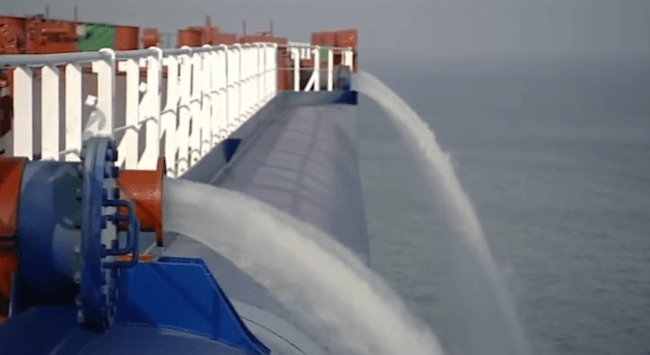IMO’s GloBallast Program: Has it Met its Expectations?
It is a known fact that the oceanic plants and creatures have been and are threatened by human actions. The oceanic life-forms are also facing a threat on account of the various activities of the shipping industry which is proving as a deterrent to the organisms’ existence and growth. This in-turn has hampered the overall fishery industry.
A grave problem that has become graver in the past decade is that of invasive marine species. These species are located in certain oceanic locations where the rocks and winds act as natural barriers and prevent them from venturing and extending their negative growth. But owing to the constant traffic by way of ships, they get transported to different oceanic locations through ship’s ballast water. This accentuates the problem on a mammoth scale. Statistically speaking, these problem causing organisms form a part of the quartet of ocean pollutants that comprise of: ocean pollution caused due to onshore activities, extensive usage of oceanic resources and unnecessary alterations caused to oceanic surroundings and ecosystem.

The ballast water carried in ships and tankers in ports causes these organisms to proliferate not just in terms of their numbers but also in terms of the extent of its reach in the oceanic arena. This proliferation of species in a different location threatens the lives of local species of that region, along with causing several other problems.
For this reason, IMO implemented what is known as the Global Ballast Water Management or the GloBallast program in the year 1993. Further amendments were made to this program in the year 1997.
As per this maritime program, it has been sought to manage nearly 7000 different kinds of debilitating organisms that get transferred inadvertently into susceptible marine areas. The GloBallast program calls for proper management of the ship ballast water by ensuring the following:
- Regular cleaning of the tanks so that no deposits and sedimentations get to thrive in the tank
- Not filling the tanks with ship ballast in areas where the organisms exist extensively. These areas include shallow ocean parts, areas where sunlight does not permeate and in ports
- The program also calls for the discharge of the ballast water in the response facilities set up specifically for this purpose
Such a thorough execution to the problem caused by encroaching organisms has led to the initiative being an enormous success. The main areas where the IMO program has been beneficial and successful can be enumerated as follows:
- The IMO program follows the public-private partnership concept. The public-private partnership allows for collaborative efforts in certain areas, between government (public sector) officials and private parties with vested interests in these areas. It calls for a mutually benefiting scenario where both collaborators get to enjoy an equal share of benefits for their equal contribution.
This public-private collaboration in the ship ballast program calls for the Global Alliance Industry (GIA) which comprises of shipping conglomerates like BP, APL and Vela Marine International. These private collaborators contribute to substantial funding which helps the GloBallast program to considerably further its R&D activities.
- On account of the thrust provided by the International Maritime Organisation for the ship ballast problem, in February 2004 there was established the International Convention for the Control and Management of Ships Ballast Water and Sediments.
This convention was to be brought into effect within a year of its adoption with ratification by at least 30 members of the IMO. It was also stipulated that these 30 members should have an international maritime gross tonnage share of at least 35%.
This convention calls for proper response facilities to ensure proper cleansing of accumulated deposits in the ballast tanks, cleaning of the tanks containing ballast water and their repairing, if required. It also calls for periodic research on the subject of management of ballast water and monitoring of the ships’ ballast water tanks.
With the help of a funding of US$ 10.2 million, the GloBallast program has more than achieved its intended purpose. However, the efforts of the program to ascertain that the management of the ship ballast is effected properly, is still ongoing. It can be hoped that in the days to come this maritime program will be completely successful in its area of vision.
You might also like to read : Importance of Maritime Labor Convention & Importance of STCW Training
Reference: Imo-Globallast
Do you have info to share with us ? Suggest a correction
About Author
Marine Insight News Network is a premier source for up-to-date, comprehensive, and insightful coverage of the maritime industry. Dedicated to offering the latest news, trends, and analyses in shipping, marine technology, regulations, and global maritime affairs, Marine Insight News Network prides itself on delivering accurate, engaging, and relevant information.

About Author
Marine Insight News Network is a premier source for up-to-date, comprehensive, and insightful coverage of the maritime industry. Dedicated to offering the latest news, trends, and analyses in shipping, marine technology, regulations, and global maritime affairs, Marine Insight News Network prides itself on delivering accurate, engaging, and relevant information.
Latest Maritime law Articles You Would Like:
Latest News
- What is the Purpose of DG Shipping?
- What are Logistics Risks?
- How Port and Terminal Operators Can Control Emissions?
- Minimum Quantity Commitment (MQC) and Liquidated Damages in Container Shipping: Concept and Relevance
- MARPOL (The International Convention for Prevention of Marine Pollution For Ships): The Ultimate Guide
- The Ultimate Shipping Container Dimensions Guide
Subscribe To Our Newsletters
By subscribing, you agree to our Privacy Policy and may receive occasional deal communications; you can unsubscribe anytime.















